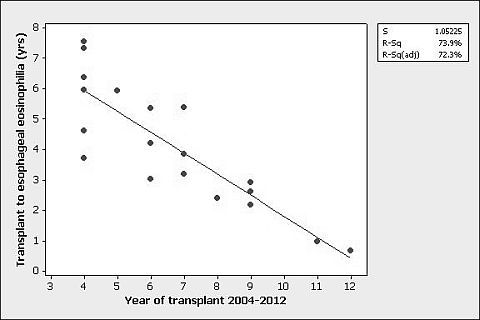Esophageal Eosinophilia after Intestinal Transplantation
Transplantation, MedStar Gerogetown University Hospital, Washington, DC
Meeting: 2013 American Transplant Congress
Abstract number: A662
Background: The prevalence of eosinophilic esophagitis (EoE) has been increasing, with estimates up to 0.1% of children. We examined esophageal eosinophilia in children after intestinal transplantation.
Method: We reviewed charts and databases of children transplanted between 2004 and 2012 at the MedStar Georgetown University Hospital. Our institute protocol includes upper endoscopy with annual evaluation for pediatric patients from the first year after intestinal transplantation.
Results: Of 79 pediatric patients 19 (24%) were found to have esophageal eosinophilia on biopsy. Of these 13 (68%) were male. The age at transplantation was: mean 2.7 ± 2.3 years, median 2.1, and range 0.6-9.3. Indications for transplantation included: gastroschesis (n= 5), necrotizing enterocolitis (n=4), malrotation/volvulus (n=4), pseudoobstruction (n=4), and intestinal atresia (n=2). The majority of transplanted grafts were liver and small bowel (n=11, 2 included a colon). The remaining grafts were: isolated small bowel (n=3), small bowel with colon (n=2), and multivisceral transplant (n=2). The time from transplantation to maximal eosinophilia was: mean 4.1 ± 2.0 years, median 3.7, and range 0.7-7.6. Endoscopic and pathologic reports were available in 17/19 cases. In 11/17 (65%), the endoscopic appearance of the esophagus was typical of EoE (i.e. characterized by linear furrows or trachealization) in 2/17 (12%), the visual features favored reflux esophagitis; and in 4/17 (24%), the esophagus appeared normal. Histological evidence of EoE (>15 eosinophils/high power field) was present in 12/17 (71%) with 9 of these 12 (75%) showing typical endoscopic and histologic findings. Thus conservative prevalence of EoE is 9/79 (11%) in our population. Regression analysis revealed a strong inverse correlation between the year of transplantation and time to development of esophageal eosinophilia [Figure 1], R sq. =72.3, p=0.00.

Conclusion: Eosinophilic esophagitis occurs in patients who have undergone intestinal transplantation. Patients should be screened routinely.
To cite this abstract in AMA style:
Khan K, Desai C, Girlanda R, Island E, Matsumoto C, Fishbein T, Kaufman S. Esophageal Eosinophilia after Intestinal Transplantation [abstract]. Am J Transplant. 2013; 13 (suppl 5). https://atcmeetingabstracts.com/abstract/esophageal-eosinophilia-after-intestinal-transplantation/. Accessed December 27, 2025.« Back to 2013 American Transplant Congress
